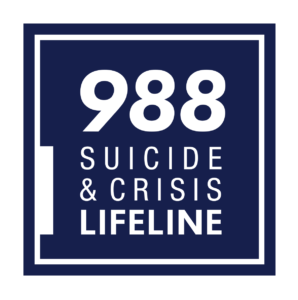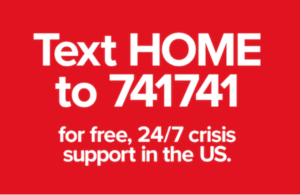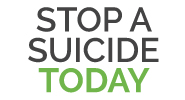ACTION STEPS
If you, a friend, or a loved one is suicidal or exhibiting any suicidal warning signs, please contact the 988 Suicide & Crisis Lifeline by calling or texting 988. You can also call your healthcare provider or go to the nearest emergency department. Treat it in the same way you would treat any other medical emergency – like choking or a heart attack – and get help immediately!

THE 988 SUICIDE & CRISIS LIFELINE: Upon calling the 988 Suicide & Crisis Lifeline, you will be connected to a trained certified crisis counselor at one of the 150 crisis centers in the Lifeline’s network. The crisis counselor can offer mental health support as well as referrals to local services. Calls are routed to the nearest available crisis center based on the caller’s area code. You can call the Lifeline (988) any time of the day or night. You can also chat online.
EVIDENCE FOR THE LIFELINE'S ABILITY TO HELP YOU, A FRIEND, OR A LOVED ONE
Lifeline counselors are trained in crisis intervention. They can provide mental health support services. The counselors can help determine whether you or your loved one is at imminent risk of engaging in suicidal behavior and in need of emergency intervention. Research by Kalafat and Gould has shown that by the end of the call, the majority of Lifeline callers feel less emotional stress and less suicidal. Data from nearly 3000 callers shows that intent to die, hopelessness, and psychological pain were significantly reduced by the end of the call.
The National Suicide Prevention Lifeline grew out of a network of crisis call centers established by the Substance Abuse and Mental Health Services Administration (SAMHSA) in 2001. Gould and her colleagues from Columbia University examined data from 1507 monitored calls to the Lifeline, focusing on crisis counselors’ practices and training across the network. The results showed that callers felt significantly more hopeful and less depressed, less suicidal, and less overwhelmed by the end of calls handled by Lifeline counselors who had been trained in the LivingWorks’ Applied Suicide Intervention Skills Training (ASIST).
In a more recent study, Gould and colleagues looked at the benefits of the SAMHSA-funded initiative to provide follow-up calls to Lifeline callers who reported suicidal ideation or “desire.” Many of those who received the calls reported that the follow up intervention stopped them from killing themselves and kept them safe. Callers said the follow up gave them hope, made them feel cared about, and helped them connect to further mental health resources. Those who were at higher risk of suicide at the time of their calls to the lifeline found the follow-up intervention to be more valuable than those at lower risk. Not every crisis center is able to offer follow-up services, but many do. Follow-ups, when offered to the caller, are optional.
Gould and colleagues’ ongoing research has found that Lifeline crisis counselors are able to assess the suicide risk and safety of individuals who are not calling on their own behalf, but whose suicide risk assessment is based on third party (i.e., someone calling out of concern for another person) reports alone. Crisis counselors and third parties are nearly always able to identify at least one intervention to aid the person at risk.
The 988 Suicide and Crisis Lifeline was launched in July 2022. The new 3-digit phone number is intended to be a quick and easy way for people who are suicidal or in a mental health crisis to connect to a trained mental health professional. Data shows that the Lifeline responded to 1.7 million more calls, texts, and chats in its first 5 months of operation, which is nearly half a million more than the old 10-digit number answered during the same period the year before. The average wait time to speak to a counselor decreased from close to 3 minutes in November 2021 to 36 seconds in November 2022. The 988 Lifeline is currently working on improving access to crisis care for marginalized communities, with pilot programs specifically for LGBTQ youth and American Indian and Alaskan Natives, and a video chatting option for people who are deaf or hard-of-hearing.
 THE CRISIS TEXT LINE: The Crisis Text Line provides free, 24/7 support via text messaging for those in crisis. Crisis is defined as “any painful emotion for which you need support.” To connect with a crisis counselor, text HOME to 741741 from anywhere in the United States. It usually takes less than five minutes to connect, but may take longer during high-traffic times. The crisis counselor is a trained volunteer who will provide support, but not medical advice. You will then text back and forth with the Crisis Counselor. The goal of any conversation is to get you to a “calm, safe place.” Sometimes that means providing you with a referral to further help, and sometimes it just means “being there and listening.” A texting conversation usually lasts anywhere from 15-45 minutes.
THE CRISIS TEXT LINE: The Crisis Text Line provides free, 24/7 support via text messaging for those in crisis. Crisis is defined as “any painful emotion for which you need support.” To connect with a crisis counselor, text HOME to 741741 from anywhere in the United States. It usually takes less than five minutes to connect, but may take longer during high-traffic times. The crisis counselor is a trained volunteer who will provide support, but not medical advice. You will then text back and forth with the Crisis Counselor. The goal of any conversation is to get you to a “calm, safe place.” Sometimes that means providing you with a referral to further help, and sometimes it just means “being there and listening.” A texting conversation usually lasts anywhere from 15-45 minutes.
A common misconception is that asking people about suicide will put the idea into their heads. This is simply not true. A recent review of 13 studies on the topic found that “acknowledging and talking about suicide may in fact reduce, rather than increase, suicidal ideation…” In fact, many people with suicidal thoughts are relieved by talking about them.
The National Suicide Prevention Lifeline has also recently initiated the “#BeThe1To” campaign. This initiative gives family and loved ones a plan with “5 action steps” for reaching out and helping those who may be suicidal. These steps are:
- Ask whether they are thinking about suicide
- Keep them safe by reducing their access to lethal means
- Be there for them
- Help them connect with support
- Follow up to see how they are doing
Learn to ACT®
What to Do if Someone You Care About May Be Considering Suicide
1. ACKNOWLEDGE
Do take it seriously. If you recognize warning signs in your friend or loved one, it is very important to take them seriously. In fact, the majority of people who die by suicide had given some indication of their intention to those close to them.
Do listen attentively. Even if professional help is needed, your friend or loved one will be more willing to seek help if you have listened carefully to them.
2. CARE
Do voice your concern. Take the initiative to ask what is troubling your friend or loved one, and attempt to overcome any reluctance on their part to talk about it.
Do let the person know you care and understand. Continue to be available to your friend or loved one and show interest and support.
Do remain calm. Although it might upset you to hear thoughts about suicide, assure your friend or loved one that you will be there for him or her and that help is available.
Do ask if the person has a specific plan. (Note: Asking about suicide does not cause a person to think about or complete suicide)
How to start the conversation:
- Mention the things that are concerning you: “You have been acting really down lately” or “You’ve been missing a lot of work and seem distracted when you are at the office.”
- Be direct: “Have things gotten so desperate, that you are thinking about suicide?” or “Have you ever thought of killing yourself?”
- Listen and remain calm
- Assure the person that help is available and treatment works
There is no perfect script for talking to someone about suicide. It is most important to show the person you care by being a good listener and offering to support or accompany them in finding help.
What to Avoid:
- Trying to cheer the person up
- Telling the person to snap out of it
- Assuming the situation will take care of itself
- Being sworn to secrecy
- Leaving the person alone (if the person is acting in a threatening way, leave and call 911)
Conversations about mental health and suicide can be tough. If you are helping someone who is dealing with intense psychological pain, you may want to seek support for yourself.
3. TREATMENT
Do get professional help immediately. If your friend or loved one is exhibiting any suicidal warning signs, assist them by contacting the 988 Suicide & Crisis Lifeline at 1-800-273-8255, crisis center, mental health professional, or local hospital emergency department.
If for any reason you are unsure, uncomfortable, or unable to take action, or if the person seems unwilling to accept treatment, please contact the National Suicide Prevention Lifeline at 1-800-273-8255.
- Take precautions to consider your own personal safety. It is important not to put yourself in harm’s way.
- Suicidal crises do not last forever. Timely intervention can make a difference and save a life. Even if someone seems angry at you for helping, in time they will be grateful for it.
Top 10 Reasons You Might Not ACT (But Should!):
Though many people give warning signs, you may question whether to take a suicidal threat seriously or question whether you should ACT.
- I’m worried, but I don’t know how to help
- They only said it because they were so angry/sad/emotional at the time
- They were only joking/assured me that they didn’t mean anything by it
- They posted on social media, so I’m sure other people will help
- I don’t know them well enough—if they meant it they would have told someone closer
- They claim they never said it—I must have misinterpreted what they meant
- They are just upset about this crisis (job loss, break up, etc.). Once it passes, they’ll be fine
- They said it to manipulate me/get back at me
- They’ve threatened before, but have never gone through with it
- They only said it because they were drunk*
*Evidence suggests that 25% of people who die by suicide misuse or are dependent on alcohol/drugs. Furthermore, nearly 50% of people who take their own life have alcohol in their system when they die. People who misuse alcohol and also suffer from depressive disorders are at an increased risk for suicide compared to people with major depression or alcoholism alone.
ACT® is a trademark of MindWise Innovations and is used in the SOS program, an evidence-based program that teaches middle and high schoolers to identify signs of depression and suicide.
